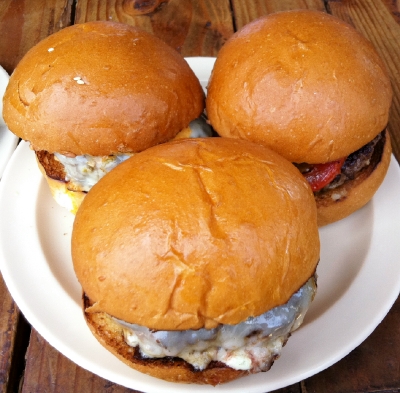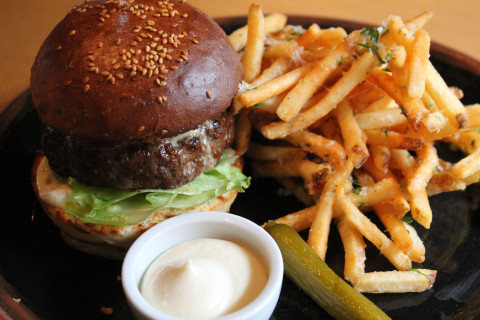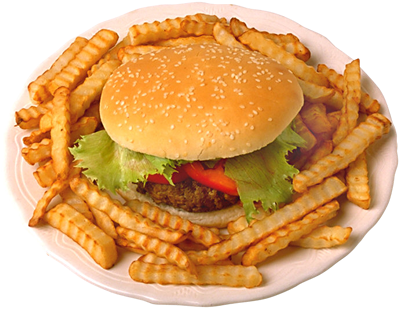
How To Make A Great Hamburger
The hamburger leads a lot of popularity contests. It may be the most often cooked dish in American homes. The space that ground meat takes up in most supermarket meat counters is evidence of that. The appeal of grilled ground meat is enormous. It's found in almost every cuisine in the world. Even though its origin was as a way to make the less-desirable majority of meat in an animal palatable, something about this mixture of lean and fat and connective tissue grabs you. And a good hamburger is very good indeed. Everybody who takes the cooking of hamburgers seriously has his (it's usually men who get worked up about this) list of musts and must-nots. And so do I. But before I begin I feel it necessary to divide hamburger cookery into two categories: thick and thin. Although most people have a preference for one or the other, I like both about equally. But the rules for cooking each are different, and in some ways contradictory.
Thick Hamburgers
Everybody who takes the cooking of hamburgers seriously has his (it's usually men who get worked up about this) list of musts and must-nots. And so do I. But before I begin I feel it necessary to divide hamburger cookery into two categories: thick and thin. Although most people have a preference for one or the other, I like both about equally. But the rules for cooking each are different, and in some ways contradictory.
Thick HamburgersWhat we're after here is a meat patty of such a great thickness that you can make the exterior crusty--nearly blackened--while leaving the inside juicy. This is my preference if I'm working with good quality beef. Round or chuck, USDA Select or Choice. (Lower grades and ungraded beef sometimes involve the use of older animals--not a plus.) Round has the lower fat content of the two, but it's higher than ground sirloin, which to my palate doesn't have enough fat to make an excellent hamburger. Chuck has more fat, and I'd say it has a slightly better taste, but it shrinks and tightens up much more when on a hot grill than round does. You can correct for that either by grinding your own chuck, and leaving out some of the fat, or by forming the patty more loosely, with visible cracks around the edges. The best way to grill a thick hamburger is on an open grill over the hottest charcoal fire you can build. It sears the exterior to the point that it's a little crunch--great mouthfeel! And it adds that incomparable smoky taste. If you're grilling outdoors, thick hamburgers are the way to go. [caption id="attachment_42657" align="alignnone" width="480"]
 Doris hamburger.
Doris hamburger.[/caption] Thin Hamburgers
However, most hamburgers are cooked indoors, in a pan or on a griddle. Even if you have an indeed grill, unless you have a very good one with commercial gas pressure, you cant get the grate hot enough to cook a hamburger as well as it could be. When my kids were little, the complained that the thick burgers both my wife and I made for them were always sort of lost inside the bun. Each bite had either too little or too much meat.
 I took a new approach, and came up with something we called Daddyburgers. They were based on the ones at Steak 'n' Shake in its prime: thin hamburgers cooked on a very hot flat-top griddle, squeezed down hard to sear the patty convincingly. They way I did it was to pat the meat out on a cutting board, then squeeze it down hard, resulting in a wide but very thin patty. So thin I have to scrape it off the board, very carefully, with a spatula. After less than a minute on the preheated (for about ten minutes) griddle, I turn and sear the other side. Another minute and they're on the toasted bun.
Until they became teenagers (after which no hamburger could be made thick or wide enough for their insatiable appetites), they loved Daddyburgers. And I took a liking to them, too, and sometimes still make them that way. Sometimes I use the hot grill to caramelize chopped onions, which with pickles and mustard makes that slider flavor.
The Fixed Rules
I took a new approach, and came up with something we called Daddyburgers. They were based on the ones at Steak 'n' Shake in its prime: thin hamburgers cooked on a very hot flat-top griddle, squeezed down hard to sear the patty convincingly. They way I did it was to pat the meat out on a cutting board, then squeeze it down hard, resulting in a wide but very thin patty. So thin I have to scrape it off the board, very carefully, with a spatula. After less than a minute on the preheated (for about ten minutes) griddle, I turn and sear the other side. Another minute and they're on the toasted bun.
Until they became teenagers (after which no hamburger could be made thick or wide enough for their insatiable appetites), they loved Daddyburgers. And I took a liking to them, too, and sometimes still make them that way. Sometimes I use the hot grill to caramelize chopped onions, which with pickles and mustard makes that slider flavor.
The Fixed RulesThese matters are important no matter which kind of hamburger you're making. 1. The elapsed time since the beef was ground should be kept to a minimum, with grinding your own right before cooking being the best of all. 2. The grill has to be as hot as you can get it. This is the biggest advantage your home kitchen has over hamburger stands, which cook their meat slowly to minimize loss. (And texture and flavor interest in the process). 3. Give some thought to the seasonings. Salt and pepper are all right, but even they have to be applied with some thought. The new hamburger seasonings in the spice rack are pretty good, as is Creole-Cajun seasoning. 4. The buns must be toasted, on both sides. 5. The dressings and sauces should not be ice-cold. That yanks all the heat out of the patty, and throws everything off. 6. This rule is controversial. If you have made a really superb hamburger, it needs nothing else. No lettuce, tomatoes, pickles, onions (well, maybe onions, in the patty), mayonnaise, mustard certainly not ketchup, or barbecue sauce. It doesn't need cheese. It really, really doesn't need bacon, which actually detracts from a well-made hamburger's flavor. 7. If you're going to put a sauce on a hamburger, invent your own. Here is mine. Tom's Hamburger Sauce This is what I slather all over the hamburgers I make at home. Aficionados of Bud's Broiler--an old local chain of charcoal-broiled hamburger joints around New Orleans--may note that this is a bit similar to the sauce on Bud's Number One. I admit that as my inspiration, but this recipe didn't come from there.
- 1/2 cup mayonnaise
- 3 Tbs. dill relish, well drained
- 2 Tbs. smoke-flavored barbecue sauce
- 1 tsp. Tabasco chipotle pepper sauce
- 1/4 tsp. coarsely-ground black pepper